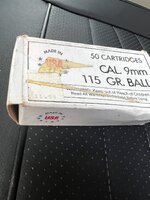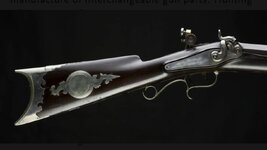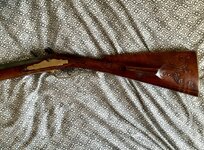I live less than an hour from there. Guess I’ll have to check it out.Shelburne VT.
Navigation
Install the app
How to install the app on iOS
Follow along with the video below to see how to install our site as a web app on your home screen.
Note: This feature may not be available in some browsers.
More options
Style variation
You are using an out of date browser. It may not display this or other websites correctly.
You should upgrade or use an alternative browser.
You should upgrade or use an alternative browser.
72,500 shots with 9 misses
- Thread starter Wprinkle
- Start date
- Joined
- Oct 22, 2014
- Messages
- 13,168
I live less than an hour from there. Guess I’ll have to check it out.
It’s defiantly worth it. There are a few rifles that I am almost certain they got the dates wrong on, but overall the rifle exhibit is excellent. What it really shows in my view is how common aperture sights really were with hunters in the 1700 and 1800’s.
- Joined
- Oct 22, 2014
- Messages
- 13,168
I’ll definitely check it out this winter.
Case in point, right off the museum website:
View attachment 954222
Oh yes. There’s probably 70-80 rifles in there, I’d guess 50+ have legit sights. The greatest collection that I’ve seen of contemporary long rifles.
It’s a whole other interest I have, but you may know that the “knowledge” of what rifles were in the 1700 and 1800’s is that they were extremely short range rifles with notch and post sights at most. Nevermind that nearly all the rifles were destroyed during the steel drives of the two world wars…. But, it’s always seemed preposterous to me that the rifleman of the era didn’t use aperture sights as the various long rifles were born out of German Jeager rifles- which commonly wore such sights. As well the belief that the rifleman only used a ridiculous drawn out affair with shot/possibles bags and not bullet boards, quick loaders, etc.
Billy Goat
“MOMMY”
When I see stuff like this it makes me wonder, how much did 22LR cost back then?
Like, 100k rounds seems to me like that would be a chunk of change back then, modern automation makes things like that cheaper.
Of course I could be wrong, I really dont know.
But hearing stories of guys splitting open stumps to reclaim lead makes it seem valuable. But, in Appalachia, everything is valuable.
Anyone got any idea, or how to figure a relative value of 100k .22 rounds from then? Like as a percentage of average income?
Like, 100k rounds seems to me like that would be a chunk of change back then, modern automation makes things like that cheaper.
Of course I could be wrong, I really dont know.
But hearing stories of guys splitting open stumps to reclaim lead makes it seem valuable. But, in Appalachia, everything is valuable.
Anyone got any idea, or how to figure a relative value of 100k .22 rounds from then? Like as a percentage of average income?
@Billy Goat that question has chatgpt written all over it. I look forward to your book report.
- Joined
- Oct 22, 2014
- Messages
- 13,168
Anyone got any idea, or how to figure a relative value of 100k .22 rounds from then? Like as a percentage of average income?
In 1910 it would be equivalent to about $1.00 a round today.
Billy Goat
“MOMMY”
In 1910 it would be equivalent to about $1.00 a round today.
I kinda figured more.
Just thinking of how it compares to sponsored events now.
Billy Goat
“MOMMY”
@Billy Goat that question has chatgpt written all over it. I look forward to your book report.
I have only used AI to create images or characters, you can use it for other things?
- Joined
- Oct 22, 2014
- Messages
- 13,168
I kinda figured more.
Just thinking of how it compares to sponsored events now.
It was human labor intensive- but human labor was way cheaper than it is now.
When I see stuff like this it makes me wonder, how much did 22LR cost back then?
Like, 100k rounds seems to me like that would be a chunk of change back then, modern automation makes things like that cheaper.
Of course I could be wrong, I really dont know.
But hearing stories of guys splitting open stumps to reclaim lead makes it seem valuable. But, in Appalachia, everything is valuable.
Anyone got any idea, or how to figure a relative value of 100k .22 rounds from then? Like as a percentage of average income?
My grandpa was born in the 1920’s and lived in what was then rural Oklahoma. As a kid he could get a box of .22 shorts for .20 but usually didn’t have it so the hardware store would sell him half a box for a dime.
Little later obviously but some context to cost.
Castle Rock
WKR
- Joined
- Mar 28, 2020
- Messages
- 1,755
Doing the same dumb stuff over and over doesn’t mean much
Ever hear of Jelly Bryce? He was a policeman and later FBI “Gman” back in the prohibition era. Once billed as the fastest gun alive. He was local to this area, I have friends whose family were friends of his.
My Grandfather tells of Mr Bryce coming to the local fair when he was a kid back in the 30’s and 40’s to put on shooting demonstrations for a crowd. He would shoot impossibly small targets while drawing and firing his 3rd model S&W 44sp or a 22 revolver. For the grand finale he would produce a silver dollar and get a volunteer from the crowd to throw it as high as they could. He would then shoot it out of the air with a 270 and the scramble would ensue amongst the kids as whoever found the dollar got to keep it. He says he never remembers him missing.
Afterwards they’d all wander over to the pavilion to listen to Bob Wills and the Texas Playboys.
Probably all of the exhibition shooters were gifted with exceptional hand eye coordination and eyesight. But they all were most likely passionate about their pursuit and practiced constantly to get as good as they were. After they’d been “discovered” many were employed by firearms and ammunition companies as traveling reps and would have had access to unlimited amounts of ammunition, guns, and targets to continue to hone their skills.
My Grandfather tells of Mr Bryce coming to the local fair when he was a kid back in the 30’s and 40’s to put on shooting demonstrations for a crowd. He would shoot impossibly small targets while drawing and firing his 3rd model S&W 44sp or a 22 revolver. For the grand finale he would produce a silver dollar and get a volunteer from the crowd to throw it as high as they could. He would then shoot it out of the air with a 270 and the scramble would ensue amongst the kids as whoever found the dollar got to keep it. He says he never remembers him missing.
Afterwards they’d all wander over to the pavilion to listen to Bob Wills and the Texas Playboys.
Probably all of the exhibition shooters were gifted with exceptional hand eye coordination and eyesight. But they all were most likely passionate about their pursuit and practiced constantly to get as good as they were. After they’d been “discovered” many were employed by firearms and ammunition companies as traveling reps and would have had access to unlimited amounts of ammunition, guns, and targets to continue to hone their skills.
RockAndSage
WKR
exceptional hand eye coordination and eyesight
Good eyesight and coordination are hugely helpful, but what's almost never mentioned outside of some pretty rarified circles is the ability to shift your eyeball focus rapidly, and your mental focus connected to those eyeballs, and connect your perception and focus to the target you're looking at without distraction. Moving your eyeball focus rapidly across multiple planes and distances across numerous targets is a physical thing, but connecting your mental focus to what you're looking at is a psychological and neurological training thing. All of it is absolutely trainable, but it's probably the least spoken-of aspect of high-performance shooting.
This is an interesting thread and a cool shooting history lesson. I'm not really up on American history (I'm Canadian), but do you think the great depression also had a factor in killing general shooting knowledge as there was less disposable income generally to devote to ammo costs? I try to read everything shooting related I can and I have noticed somewhat of a trend among gun writers of a certain era who either grew up then or had parents who grew up then who liked to mention that shooting more than necessary was generally frowned upon as wasteful. It was also around this era that the 3 shot group started gaining traction.Indeed. As well the two world wars did more to kill actual high level knowledge of shooting as a whole than anything else. The path the shooting world was on was spectacular: real data, real information, and with shooters/competitor’s shooting massive quantities of ammo per year. In just a couple of decades it went from custom rifles proof groups from the builders being 20 to 50+ shots per group as a standard, to “well the only thing that matters is the first 3 shots”.
- Joined
- Oct 22, 2014
- Messages
- 13,168
This is an interesting thread and a cool shooting history lesson. I'm not really up on American history (I'm Canadian), but do you think the great depression also had a factor in killing general shooting knowledge as there was less disposable income generally to devote to ammo costs?
Sure it did. But the WWI had a huge hand in the depression.
HuntHarder
WKR
Only 9 misses is pure BS.
I had no idea! I live 45 minutes away from that museum and I build longrifles. What a resource!!Oh yes. There’s probably 70-80 rifles in there, I’d guess 50+ have legit sights. The greatest collection that I’ve seen of contemporary long rifles.
It’s a whole other interest I have, but you may know that the “knowledge” of what rifles were in the 1700 and 1800’s is that they were extremely short range rifles with notch and post sights at most. Nevermind that nearly all the rifles were destroyed during the steel drives of the two world wars…. But, it’s always seemed preposterous to me that the rifleman of the era didn’t use aperture sights as the various long rifles were born out of German Jeager rifles- which commonly wore such sights. As well the belief that the rifleman only used a ridiculous drawn out affair with shot/possibles bags and not bullet boards, quick loaders, etc.
Attachments
@RockAndSage I would love to hear more about this, if your wouldn’t. I’ve been looking for resources on this type of testing/practice.Moving your eyeball focus rapidly across multiple planes and distances across numerous targets is a physical thing, but connecting your mental focus to what you're looking at is a psychological and neurological training thing. All of it is absolutely trainable, but it's probably the least spoken-of aspect of high-performance shooting.
RockAndSage
WKR
Sure it did. But the WWI had a huge hand in the depression.
To support this point...
Even though we had the Roaring 20s for a decade after the WWI here in the US, the overall volume of global trade that WWI killed in 1914 didn't recover to the same level until 1953.
And from 1953 to 1973ish, we had an economic boom and an explosion in quality of life, driven by global trade again. Oil wars/politics hammered the 70s, and things started picking back up again after about 1985, and went into overdrive in the 1990s.
I came across this in a box of my dad's reloading stuff awhile back - it's a box of the cheapest 9mm FMJ ammo, purchased in 1985 at a LGS. Take a look at the price tag. Fast-forward 40 years and 3 decades of global free trade, cheap 9mm is still this price, and was even cheaper before the political panics and Covid of the last 15 years:

Similar threads
- Replies
- 8
- Views
- 288
Featured Video
Latest Articles
- TT#64 Josh Boyd Elk Hunting Strategies for Every Season
- Aaron Davidson of Gunwerks
- TT#63 Dirk Durham’s Art of Elk Calling
- BIG Buck Stories with the Dirty Giants Podcast
- TT#62 Brian Barney Hunting Bulls without Calling
- Hoyt Alpha AX-2 SD Review
- Kuiu Kenai vs Outdoor Vitals Vario Hooded Jacket Review
- Hoyt RX-9 Ultra Review
- Hunting Vampire Bucks & Building an Optics Kit
- Darton Sequel ST2 35 Review


